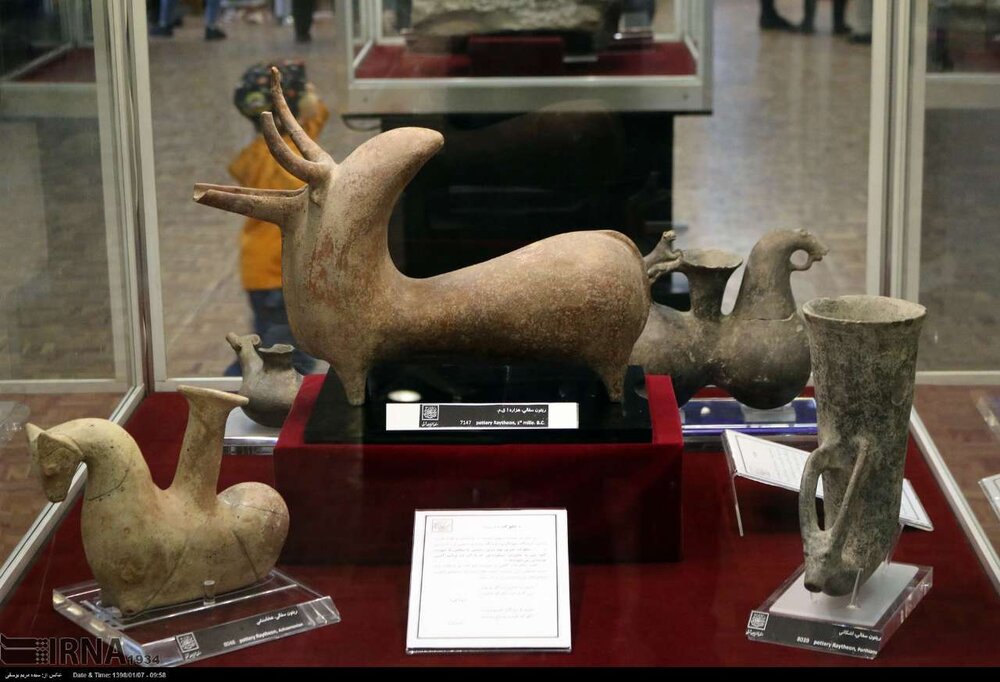Azarbaijan Museum: intimate but intricate slices of Iranian history

TEHRAN –Azarbaijan Museum, which is located in the ancient city of Tabriz, may seem quite modest at the first glance, but it is chock-full of Iran’s rich history.
It showcases thousands of objects from Persian, Mesopotamian, and Elamite antiquities to masterpieces by Islamic-era artists.
Upon entering, one will be captivated by the garden’s impressive inscriptions and several towering bronze statues, mostly stone artifacts from the Islamic era. The museum has a library and a small restaurant as well.
The entrance has a large brick gate with a large wooden door guarded by two stone rams that usher to administrative and trade seals as well as coins minted by ruling powers, including the mighty Achaemenid Empire (c. 550– 330 BC).
Highlights include relics excavated from Tepe Hasanlu, a superb millennia-old copper helmet, and a re-weave of the illustrious ‘Ardabil’ carpet, reckoned to be one of the best made; the original is beautifully displayed in the Victoria & Albert Museum in London.
Rare documents, potteries, metalwork, glasswork, handwoven textiles, woodwork, carpets, manuscripts, candlesticks, and archaeological remains are among other objects on view.
There is also a solo exhibit dedicated to sculptural allegories of life and war created by the Iranian sculptor, Ahad Hosseini.
Moreover, the museum has a section dedicated to the Persian Constitutional Revolution (“Enghelab-e Mashruteh”), which took place between 1905 and 1911, leading to the establishment of a parliament in Persia (Iran) during the Qajar era. This section showcases belongings and photographs, among other objects.
In addition, visitors are offered remarkable works of art from European countries, such as bronzes and ivory and bone handcrafted pieces, as well as oil paintings.
It is no surprise that the Azarbaijan Museum is sometimes referred to as the second major museum of cultural heritage after the National Museum.
Designed by French architect Andre Godard and built by Iranian experts, the Azerbaijan Museum is located next to the majestic Masjed-e Kabud (“Blue Mosque”).
The capital city of Tabriz, which is soaked in history and culture for millennia, embraces several historical and religious sites, including Jameh Mosque of Tabriz and Arg of Tabriz, and UNESCO-registered Tabriz Historic Bazaar Complex to name a few.
It became the capital of the Mongol Il-Khan Mahmud Gazan (1295–1304) and his successor. Timur (Tamerlane), a Turkic conqueror, took it in 1392. Some decades later, the Kara Koyunlu Turkmen made it their capital.
Tabriz retained its administrative status under the Safavid dynasty until 1548 when Shah Tahmasp I relocated his capital westward to Qazvin. During the next two centuries, Tabriz changed hands several times between Persia and the Ottoman Empire. During World War I, the city was temporarily occupied by Turkish and then Soviet troops.
Tabriz was declared a world craft city of carpet weaving by the World Craft in 2016. It also bore the title of the Islamic Tourism Capital in 2018.
Here is a selection of comments that visitors to the museum have posted to TripAdvisor, one of the most popular travel websites in the world:
“Interesting”
It mostly contains objects discovered from excavations in Iranian Azarbaijan, also some artworks and sculptures of artists. Apart from the National Museum of Iran in Tehran, the Azarbaijan Museum has the largest collection belonging to different periods of Iran’s history. You will have lots of useful information about Iran’s history. (Banafshe Tehrani from Tehran, Iran)
“Small but very well done”
Good exhibits from the Urartic period, some Luristan bronzes, and a number of others. Good signage. Excellent bookshop especially for books in Farsi, but I also found books in English that were nice to have. (KrisfromSF form San Francisco, the U.S.)
“A must for Tabriz”
Went there as a family with kids ranging from ages 8-17. It was really spectacular, and a lot of artifacts are well over 2000 years old! Kids of all ages will find it fascinating, and the guide said it was the most important museum in Tabriz. A must for anyone who loves history and would like to learn more about Iran. Overall great experience. The staff is very friendly and helpful, too. (Mohadeseh from Kuwait City, Kuwait)
“Very good place to visit”
Interesting artifacts from everywhere in Iran… also very interesting coins from early Iranian kingdom(s) till now. (Faridfa from Elounda, Greece)
“Amazing”
I was too excited during my visit to the Museum. It was not only about Iran. Don’t lose it if you were in Tabriz. (Fredy_Amst from Amsterdam, the Netherlands)
“Azarbaijan Museum is Awesome!!!”
The Azarbaijan Museum in Tabriz, situated next to the famous Blue Mosque, maybe the nicest museum in Tabriz. It consists of three parts. When you enter, you will find the archaeological department, which tells the story of Azarbaijan from the fifth century until the Sassanian Age. On the first floor are displays of coins, from the Achaemenid period to the nineteenth century and seals (from prehistory to the Sassanian age). In the basement is a small restaurant, but here you will also find several tall bronze statues by Ahad Hosseini, an artist born in Tabriz. (Tarana B from Baku, Azerbaijan)
“Nice small museum and they offered us the most amazing figs”
The Azarbaijan Museum, close to the blue mosque, is relatively small but has a nice instructive collection of artifacts from prehistoric times to nearly the present. These include arrowheads, swords, pottery, as well as a coin collection. We spent perhaps an hour here. Notably, while wandering around, the staff came up to us and offered us the most amazing figs, for those alone, it would be worth returning. (Astrito; from Ulm, Germany)
AM
